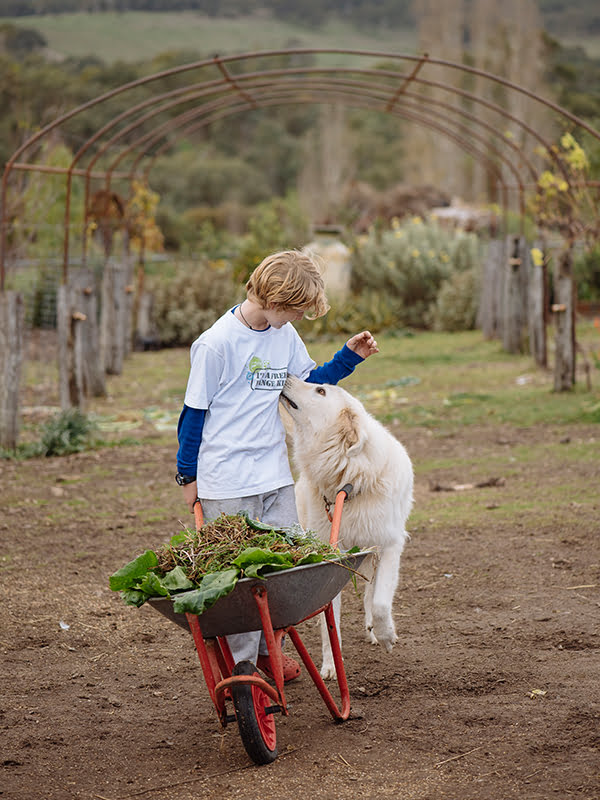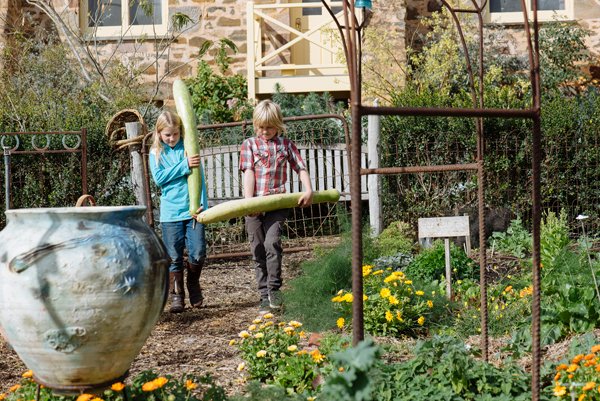When it comes to designing child-friendly gardens there are some important guidelines to keep in mind. There are 10 features that I think are essential in all gardens, especially where children or grandchildren will get to play. Shade, lawn a sandpit and water are just some of these.
Shade Some shade is essential in our climate. Rather than rely on long-term artificial shade from canopies or shade sails, develop natural shade from plants. Plant trees or grow vines over pergolas for their wonderful cooling shade, canopy and habitat. Trees take time to grow and create shade when you’re starting with a blank canvas; however, when buying a property, be aware of what a bonus shade trees are. Larger trees also let kids learn to climb trees and offer endless tree-house possibilities. Parents tell me they want to plant a tree for their kids to climb, but they don’t think through the fact that it might be 10 or even 20 years before the tree will be big enough to climb. When buying a family home, look for a property with an established tree already in the garden or just accept that planting a tree now is for future grandchildren to climb.
If your chosen play space has no shade, install a temporary shade-sail structure until the trees you plant grow. Alternatively, look at creating a strong structure for fast-growing edible climbers such as New Guinea beans or tromboncini (a type of climbing zucchini with trombone-shaped fruits), or a non-edible gourd. As gourds grow and begin to form fruits, they’ll fascinate kids. Gourds come in weird and wonderful shapes and also give the opportunity for endless nature craft activities when you eventually harvest the gourds. All these climbers are planted into warm soil in spring and grow rapidly to create cool shade through summer. All are capable of growing 5–7m by late summer. As their fruits can get very heavy, build a strong support structure.

Lawn From a fun perspective, there is so much play that can be done on lawn that’s simply not comfortable on hard surfaces. If you happen to have sloping land, nothing beats rolling down a lawn. On a practical level, lawns have a tremendous cooling effect on a garden area, and on a more personal level, there’s something wonderful about walking barefoot on grass – it’s immediately grounding and calming. I’m a big fan of lawn in the right place, and with the new waterwise varieties and subsurface irrigation techniques now available, lawns need not be considered the water guzzlers they once were.
Space that’s not filled with garden or structures allows kids to run and play, whether it’s for games of chasing, ball games, hide and seek or treasure hunts. Where yards are too small to allow for games of cricket or kicking a footy, these pursuits can be enjoyed in the local park. I believe kids also need to be able to run on lawns, and if you can be a little more relaxed with your lawn, mow patterns in it (leaving the surrounding grass a longer) to make running or riding tracks.
Sandpit Pits provide hours of entertainment for children of all ages. Rather than have something edged with plastic, pavers or concrete, use logs, cut wooden blocks set at staggered heights, or large stones that can double as stepping stones to help teach gross motor skills, agility and balance. If you’re game, allow space for a mud pit where your kids are allowed to dig, make mud pies and get muddy. Although some parents may stress at the thought of muddy kids, dirty clothes and mud being trampled through the house, it will create treasured memories for your kids. Wash mud off with a garden hose outside before they come in for a bath!
One of the first things we built at Sophie’s Patch, even while we were renting, was a large sandpit, two sleepers long by one sleeper wide, which worked well as our tribe of five kids needed to have enough space to play and build. Even though we no longer have a sandpit, it served our family well till the youngest were over 10 years old.
Water Having a water feature or a safe way for kids to play and interact with water is great. On hot days, nothing’s more enjoyable for children than running through a sprinkler on the lawn. If you also use this to water your lawn, it’s a no-waste win–win! Water in the garden can simply be a bucket of water used in the sandpit. Whatever it is, we need to teach our children to be extremely safe around water and that water is a limited resource that shouldn’t be wasted. Some rules regarding just how much water kids are allowed to use may be necessary (unless you have a stream running through your backyard); however, know that teaching kids that water is a precious resource is a valuable lesson in sustainable living. Recycling Teaching kids about recycling needs to take place out in the garden as well as inside the home. It can be as simple as a worm farm or compost system to show recycling green materials, to fanciful artworks, or practical things such as an outdoor table and benches made from old hardwood pallets.
Kids picking produce from the garden
Produce Being able to grow at least some fruits, vegetables and herbs, even where space is limited, teaches children where their food comes from. You can be productive in a garden of any size, even in a small courtyard or balcony, by using vertical spaces or growing herbs in containers. Interesting plants I think that all plants are amazing; however, if you only have two different plants in your backyard, repeated 50 times, they may not catch a kid’s attention or imagination. Also, if the plants are perfect hedge plants, which the kids are not allowed to get near in case they damage them, your kids may even grow to resent the garden. Choose a practical design with ‘kid-proof ’ or resilient plants near the edges of garden beds to take the wear and tear of kids, balls and bikes. Choose a wide variety of interesting plants with different forms and habits, foliage and flower colours, flowering times and seasonal habits. Habitat for insects and other wildlife Birds and insects are naturally fascinating to most kids. Any insect phobias they have are often transferred from their parents. One way to encourage kids to marvel at nature is by us demonstrating a healthy fascination and respect for wildlife. If you have created a garden with diverse plants that encourage a rich biodiversity, together you and your children can watch a spider spin its web, a butterfly’s glorious flight or bees busily working around flowers, and you can transfer this lifelong love to your children. Teaching our children to observe without touching can be important, and it might be that when you find a centipede scurrying under mulch you explain that these creatures are amazing because they can live up to 15 years, but they are not ones we want to touch. Try to encourage wildlife in the garden by having shallow bowls of water for birds and other insects. Most nurseries and garden centres sell small insect hotels that offer nesting sites for insects, or build your own and call it a mini beast house. Build or install a bat or bird box so your kids observe who moves in. (Wildlife gardening is discussed in more detail in Chapter Ten.)
Use tree branches to create a cubby house the kids will love.
Cubbyhouse Many parents, including me, aspire to build their child the best, most schmick cubbyhouse they can. The first one we built at our previous property was amazing, and I would have loved it as an office, although the scale was a bit small. It was a little corrugated-iron cottage built out on a platform with a cute blue picket-fenced verandah. You could exit via a slide from the verandah to the garden below! Despite all the effort that went into it, I hate to admit that our boys really didn’t care much for it. It was my dream not theirs, and the reality is that they had much more fun building their own out of large cardboard boxes, sticks or planks of wood. If kids are involved in designing and building something, they’ll enjoy it much more than an expensive, store-bought one. Teach and encourage kids to make teepee-style cubbies out of sticks, logs and rope. Once this skill is mastered, they can make and remake cubbies to their heart’s delight. You could also help them to build a teepee out of stakes then grow quick-growing climbing plants over it, such as sweet peas, edible peas or beans. For the kids to be able to build their own cubbies, have materials on hand for them to use and an area available where they can make a mess and be creative without upsetting your ‘garden plan’. Kids are young for such a short space of time, so why not let them enjoy it? Crawling tunnels These are a fun way to create access to ‘kids only’ areas. Kids have to climb through them to get to their cubby. Tunnels can be made from arched branches or metal rods woven or covered with climbing plants. They could also be made from a close planting of sunflowers. If the kids are involved in the planning and building of these tunnels, they are more likely to use, treasure and look after them.
Find out more
This is an extract from Sophie Thomson’s latest book, Sophie’s Patch. Find out more https://sophiespatch.com.au/

